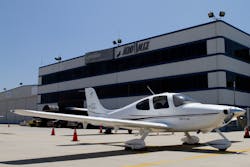All airport managers should be familiar with the old adage, “If you’ve seen one airport, you’ve seen one airport.” Nothing could be closer to the truth when it comes to the current national debate regarding the evolving fixed based operator (FBO) business model.
While some FBOs continue to rely on fuel sales and bundling of services for revenue (i.e., the traditional U.S. model), in many markets, as a means to compete and remain sustainable, FBOs are accommodating customers by providing competitive fuel prices and a menu of services. Thus, they have introduced individual fees for services such aircraft parking and handling (i.e., the European model) in light of diminishing fuel margins that challenge healthy FBO operations at general aviation facilities.
Through the years, due to the increased trend away from the bundled approach to FBO operations, some light general aviation aircraft owners have expressed concerns about pricing practices that could preclude reasonable access to public-use airports. This raises significant challenges for airport sponsors whose federal grant assurances require them to operate self-sustaining enterprises, while making the airport reasonably available for public use without discrimination. Airport management, like politics, is local. Unfortunately, national pressure or debate applied at a local level does not properly reflect a specific community’s goals or consensus on what is best for its airport.
As acknowledged by the Federal Aviation Administration (FAA) in its 2017 document entitled “Q&As – FBO Industry Consolidation and Pricing Practices,” changes in the aviation industry in recent years have put FBOs under stress due to post-911 security demands and continued consolidation of the industry. Likewise, many FBO operations and facilities are under pressure to upgrade their facilities, where some buildings are functionally obsolete and not able to accommodate today’s aircraft fleet. While most arguments regarding FBO pricing practices are presented from the viewpoint of the airport user, this article examines the perspective and responsibilities of the airport sponsor.
How do airports fund and preserve the integrity of light general aviation aircraft/users, while fulfilling the obligation to be self-sustainable? How does the airport sponsor use reasonable discretion to support its users in coordination with policies to develop properties for the highest and best use, especially in light of limited AIP funds and a lack of legislative support for increased PFCs that may be available for new airport development?
Much like the evolution of the airline industry after deregulation, airport sponsors have no control over the forces of a free market or the FBO industry consolidation caused by changing economic conditions. Since each airport and each market is different, and based on local and regional knowledge and conditions, FBOs construct pricing that enables them to provide quality service at a reasonable rate of return. In addition to the FAA’s compliance policy that requires aeronautical service pricing to be reasonable, the Department of Justice does attempt to manage and/or prevent monopolies. Ultimately, what is defined as reasonable may vary from market to market.
The most appropriate model of pricing may come from evaluating the merits of both the American and European models, and implementing the best practices of each. For example, based on an airport’s unique operations, it may be appropriate for the airport sponsor to erect a self-serve fueling station with parking designated for transient, light general aviation aircraft that do not require the fuel, ramp space or pilot/passenger amenities provided by an FBO. In some cases, the airport might provide incentives for an FBO to create and sustain a lower cost self-serve fueling station consistent with its business model.
In terms of transient parking, setting aside a ramp area for light general aviation aircraft may serve the interests of an FBO whose overhead costs are growing and fuel margins are shrinking. For example, in light of fixed daily operating costs, an aircraft that utilizes an FBO’s ramp space without buying fuel or other services (i.e., without contributing to its revenue stream) is actually an expense to the FBO and the airport. In today’s environment, the ability for an airport to provide unsupervised, unfettered access does create risk. Rather than the airport sponsor funding this designated ramp area with necessary access control, the investor FBO could develop the property and amortize the expense over the term of the entire FBO’s master leasehold.
It is unreasonable to expect airports to apply grant assurances that satisfy user demand without giving equal consideration to all the assurance requirements with which it must comply under federal law.
This year, the Transportation Safety Board’s Airport Cooperative Research Program (ACRP) published “Synthesis 86: Airport Operator Options for Delivery of FBO Services,” a report that explores the local considerations on how airports can provide FBO services and evaluate which business model works best.
According to this document, other major considerations for airport sponsors to consider include the level of interest exhibited by the private sector to provide sustainable investment opportunities. As a last resort, where private investment cannot be sustained, an airport may provide them directly under the FAA’s permitted exclusive rights provision.
Notably, the ACRP “Synthesis 86” identifies the nation’s estimated 3,500 FBOs in 2016, compared to some 10,000 that were operating in the 1980s. Most surprisingly, 47 percent of the nation’s FBOs are municipally owned and operated by an airport sponsor.
Overall, research indicates that there is not a one-size-fits-all approach to pricing, that the definition of what is reasonable is not universal, and that the European model should not be completely dismissed as a viable alternative to the traditional U.S. model. Thus, this begs the question on where the line would be drawn on reasonable pricing beyond FBOs. Would flight schools, aircraft maintenance and charter management providers face similar expectations by having the federal government manage reasonableness in these pricing areas too?
How can airport sponsors navigate the path to both sustainability and diversity? By initiating dialogue among all stakeholder groups and solving problems to the largest extent possible at the local level. Creating an environment that promotes a healthy mix of jet, propeller and helicopter operations and facilities requires close collaboration among airport sponsors, users and operators. Incentives to preserve a diverse airport may take the shape of new leasing policies, rates and fees, and investment requirements. In all cases, industry and airports should work together.
When airport users have concerns about a particular airport’s rates and charges, they should address them first with the local FBO and then with the airport sponsor/management. The FAA supports this type of direct communication, especially in matters involving airport access, fees, rates and charges. Any attempt to circumvent this process in the political realm only restricts true collaboration, compromise and problem-solving.
As a last resort, the FAA provides the Part 13 and Part 16 actions that permit informal and formal administrative actions to evaluate and provide determinations on challenges against an airport sponsor. Evidenced by the determinations in these cases, there is no clear “cookie cutter” procedural process that will eliminate the need to evaluate each situation independently. Avoiding this administrative process is best for all parties.
The concept of affordability at airports is a worthwhile and necessary industry pursuit, but its definition varies and airport sponsors must work collaboratively with the aviation communities they serve to develop incentives and leasing practices that allow and encourage all of the various general aviation users to live in harmony. The bottom line is the industry cannot expect new infrastructure to be developed, maintained and secured without a cost, and at the taxpayer’s expense.
Curt Castagna, president and CEO of Aeroplex/Aerolease Group, is a member of the Los Angeles County Airport Commission, president of the Van Nuys and Long Beach Airport Associations, and a board member of the National Air Transportation Association. A certified private and instrument-rated pilot, he has instructed courses in aviation administration at Cal State Los Angeles for over two decades.
About the Author

Curt Castagna
President and CEO
Curt Castagna, President/CEO of Ascension Group Partners, serves as president and CEO of the National Air Transportation Association, member and past chair of the Los Angeles County Airport Commission, and president of the Van Nuys and Long Beach airport associations. A certified private, seaplane and instrument-rated pilot, he continues to instruct courses in aviation administration at Cypress Community College and Cal State Los Angeles.
